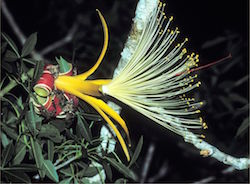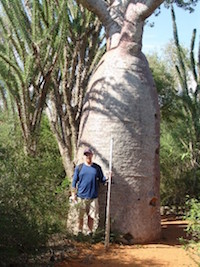 Flower of Adansonia rubrostipa (Photo courtesy of Zachary Rogers)The Gila Native Plant Society’s February meeting will feature a presentation by Zachary Rogers, “Madagascar: The Red Island - A Naturalist’s Paradise”.
Flower of Adansonia rubrostipa (Photo courtesy of Zachary Rogers)The Gila Native Plant Society’s February meeting will feature a presentation by Zachary Rogers, “Madagascar: The Red Island - A Naturalist’s Paradise”.
As Zachary explains: “Madagascar, the fourth largest island in the world, is home to tens of thousands of native species of plants and animals that occur only there and nowhere else. Over millions of years, these fascinating endemic species have evolved specialized, often unique, adaptations for survival. All this has taken place in isolation from ancestors living on nearby landmasses like eastern Africa, India, and small Indian Ocean archipelagos. Sadly, Madagascar, as a slowly developing country, also has one of the most highly threatened floras and faunas in the world.”
Join us along with New Mexico State University herbarium curator Zachary Rogers, who will guide us on a virtual tour of the island surveying its “mega-biodiversity”, while showcasing recent taxonomic plant research and new conservation efforts aimed at protecting the rarest, most threatened species.
About our speaker:
 Zach with baobab tree (Adansonia rubrostipa) (Photo courtesy of Zachary Rogers)Zachary Rogers grew up in Missouri along the Mississippi River, spending weekends out on the family farm. His mother, an elementary school teacher, sparked his interest in science at an early age, and science fairs and camps expanded his fascination with natural history. Transferring from pre-med to an ecology program with an emphasis on botany, he earned his undergraduate and graduate degrees in biology at the University of Missouri.
Zach with baobab tree (Adansonia rubrostipa) (Photo courtesy of Zachary Rogers)Zachary Rogers grew up in Missouri along the Mississippi River, spending weekends out on the family farm. His mother, an elementary school teacher, sparked his interest in science at an early age, and science fairs and camps expanded his fascination with natural history. Transferring from pre-med to an ecology program with an emphasis on botany, he earned his undergraduate and graduate degrees in biology at the University of Missouri.
In 1999 he joined the Research Division of the Missouri Botanical Garden in St. Louis, one of the top centers of plant research, conservation, and horticulture in the world. Working in the herbarium, Zach quickly gravitated toward the identification and classification of tropical plants. His early research focused on the flora of Ecuador. A few years later he began studying the flora of Madagascar and soon developed an interest in the plant family Thymelaeaceae, also known as the “Mezereum” or “Daphne” family, a group of about 1,000 species found in the tropical regions of Africa, Asia, Australia, and the Americas.
Over the past 20 years, Zach has published extensively on plant biodiversity, including the naming and description of many species and genera new to science, and he has collected thousands of herbarium specimens made during field trips to unique ecosystems in remote parts of Madagascar, South Africa, Ecuador and Mexico.
In 2017 Zach’s wife Sara, also a botanist, relocated to New Mexico to take a position as an assistant professor and herbarium curator at New Mexico State University. A few months later Zach left the Missouri Botanical Garden to join Sara at NMSU in the Animal and Range Sciences Department. In 2018 Zach and Sara received a joint award from the National Science Foundation to improve the existing infrastructure of the two herbaria at NMSU. The aim is to increase the visibility of the University’s collection of 120,000 plant specimens, a great resource for teaching, research and outreach.
The Gila Native Plant Society will hold this month’s meeting at 7:00 pm, Friday, February 21, 2020, in Harlan Hall, Room 219, on the WNMU campus, at the corner of 12th and Alabama Streets in Silver City. All are welcome; Gila Native Plant Society meetings are free and open to the public. Refreshments following the program. For further information visit the programs page on our website: http://www.gilanps.org/events/programs/.
The Gila Native Plant Society is committed to promoting education, research and appreciation of the native flora of the Southwest; encouraging the preservation of rare and endangered plant species; and supporting the use of suitable native plants in landscaping. For information on programs, publications and membership, please visit www.gilanps.org